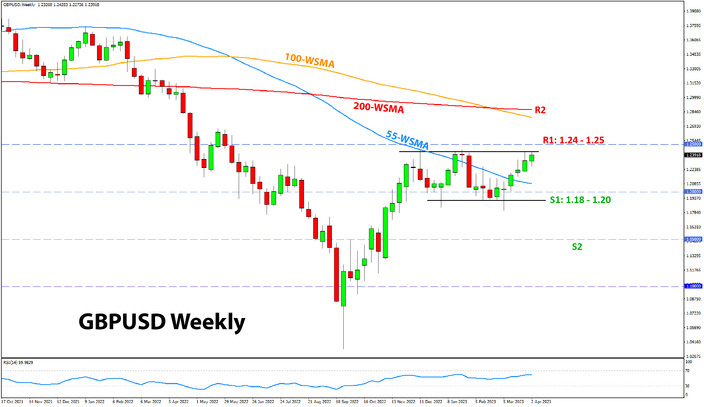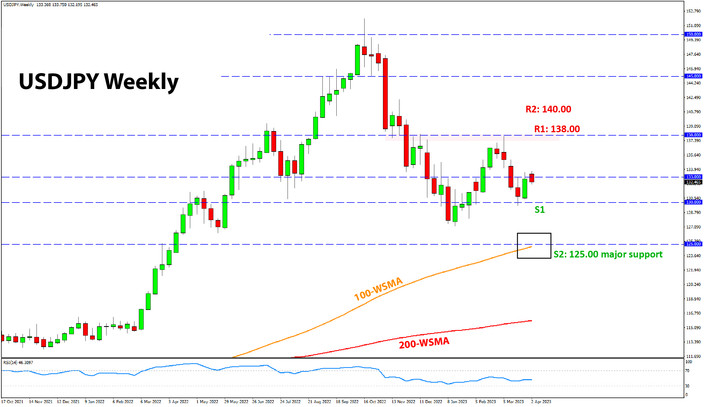USD Fundamentals: Busy US Calendar This Week; Fx Traders Watching ISM PMIs and NFP
The US dollar closed another week lower - the fifth in a row - following the notable rebound in February. The USD move down comes amid dovish repricing of Fed interest rate expectations following the banking crisis. Essentially, markets now believe that the Fed will be cutting rates already later this year as inflation will fall further and the economy will weaken. This is the bet most investors are now taking by being long stocks, bonds, and gold, while shorting the dollar.
This dovish Fed narrative is keeping the dollar under pressure. For this narrative to stay intact, it will need more weakness in US economic data, particularly jobs (released this Friday). However, should US data prove more resilient than the pessimists believe (like it did in February), the US dollar will likely rebound.
The week ahead will be a very active one for USD pairs as we have the ISM manufacturing PMI (already out today at 46.3 vs 47.5 expectations) and the ISM services PMI due on Wednesday. The Nonfarm Payrolls will be released on Good Friday this month, which means most traders will be off for the holiday. The thin volatility in this situation can potentially exacerbate the market reaction to the NFP report.
EUR Fundamentals: Consistently Hawkish ECB Keeps EUR Supported
The euro currency remains very resilient, underpinned by consistent hawkish ECB communication. As COT positioning data shows, the market is now firmly long euros with a similar size as during the peaks in 2018 and 2021. All else being equal, the stretched positioning to the long side means further gains will not come as easily, and thus, we should remain cautious in chasing EUR rallies.
On the other hand, EUR positioning leaning heavily to the long side means that any surprises in the opposite direction (EUR bearish) are likely to have an outsized market reaction to the downside. For now, the market is overwhelmingly bullish EUR, and it’s usually not wise to fight the trend. But if a reversal happens, it will be no surprise if the EUR quickly tumbles lower.
The Eurozone calendar is quiet this week, with only 2nd tier reports scheduled, like the final services and manufacturing PMIs. The final reports have a muted market impact compared to the flash reports, as they are released about two weeks later.
EURUSD Technical Analysis:
EURUSD has recovered almost completely from the February fall and is now again testing waters around the 1.09 level, not far from the previous high and major psychological zone at 1.10. Indeed, 1.10 remains a key resistance zone that is likely to prove tough to break.
Both the 100 (orange) and 200 (red) weekly moving averages are located in the area around 1.10. The 100-week MA is at 1.0950, while the 200-week MA is located at 1.12. This makes the whole 1.10 - 1.12 area a big resistance. Crucially, this is also where the 20-year trendline stands, which was broken in February 2022 when Russia invaded Ukraine.
The confluence factors here at 1.10 - 1.12 make for a very robust resistance zone. So, even if EURUSD breaks above 1.10, it won’t be a convincing signal for bullish continuation.
To the downside, the 1.05 zone is the first support on the weekly chart.
GBP Fundamentals: Sterling Rallying With Risky Assets
Risk sentiment remains well-supported, helped by market expectations that the tightening cycles of most big central banks are coming to an end (led by the Fed). This helped to produce another strong close higher in global stock indices (e.g., NASDAQ, S&P 500, DAX) and is providing ongoing support to risky currencies such as GBP at the expense of the US dollar.
The UK calendar is also very light this week, which means risk sentiment and global factors will remain the main market drivers for GBP. Of note will be BOE speakers such as MPC members Tenreyro and Pill tomorrow (Tue) and on Wednesday.
The conclusion is that GBP remains closely correlated with risk sentiment. As long as stocks stay near their recent highs, GBP will stay supported too.
GBPUSD Technical Analysis:
GBPUSD climbed by some 350 pips in March (monthly open to close), and these gains have taken the pair to again test the upper end of the range around 1.24. The 1.25 psychological level is also nearby. Thus, this resistance can be considered a wider zone above 1.24 and around 1.25 (1.24 - 1.25).
GBPUSD has formed a horizontal range since December last year. The technical situation is thus clear here. Support is located at the bottom of the range under 1.20 and toward the lows at 1.18. The support zone can be defined as 1.18 - 1.20.

JPY Fundamentals: BOJ Leadership Change This Week
Interestingly, the yen is an underperformer in the current environment and closed weaker than the US dollar (USDJPY higher) in the past week. Some stabilization of banking turmoils and the rebound in bond yields is the reason behind the JPY’s underperformance last week. However, the focus will soon return to the BOJ and potential policy adjustments they may make. Current Governor Kuroda’s term ends this Saturday (April 8), and Kazuo Ueda will take office as the new leader of the Bank of Japan.
The market is eagerly awaiting to hear more from Ueda, and this will likely have the biggest impact on JPY pairs going forward. Speculations continue that he will soon put an end to the YCC policy, effectively a hawkish change at the long-standing dovish BOJ. Under such a scenario, we can expect JPY appreciation. USDJPY should decisively break 130.00 and fall at least toward 125.00 in this case.
However, there is no timeframe for when the new BOJ leadership may announce a policy change. In fact, they may even surprise dovish by saying that no policy change is needed for now. Such an outcome would see the opposite reaction in USDJPY, likely spiking above 137.00.
USDJPY Technical Analysis:
USDJPY rebounded strongly last week and closed around 250 pips in the gree. The tall green candle has formed a bullish engulfing candlestick pattern right at the 130.00 zone. This has now made 130.00 a “stronger” verified support zone.
To the upside, USDJPY bulls will be looking for the 135.00 level to be reached. Above it, the focus will return to 138.00 and then 140.00 as key resistance zones higher.
The early year lows around 127.00 are the first support zone below 130.00. However, 125.00 should remain a more important support for USDJPY, particularly given that it is where the major peak from 2015 reversed.






